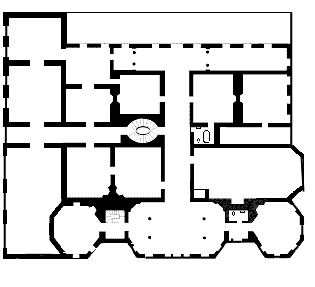| Stoney Grove Prepared by Nigel Twicks |
|||||||||||
| Visit the Stoney Grove Bookshop
in association with |
|||||||||||
|
Stoney Grove was essentially created by one man, a few women and the passage of time. William Blake was a trader in London who made his fortune in the latter part of the eighteenth century, reportedly from the China trade. Keen to establish himself amongst the wealthiest of the nation, he completed Stoney Grove in 1782. Blake commissioned architect Culpability Heath to build the house in classic Palladian style and design the surrounding landscape. Sadly, William survived only two years after the house was completed. Remarkably, the house remained within the family line until the passing of its last member in 1995. It stood empty until recently purchased by Ann Simmons and Simon Tinsley. Exploration and restoration are needed at Stoney Grove to determine if the house has been substantially changed and to assess the age of its remaining decoration and furniture. Little is presently known about the extent of alterations made to the house over time. There is some evidence that Blake’s widow Fanny introduced the French neo-classical style to the house and furnishings after her husband’s death. It is suspected that the building was altered in the nineteenth century, under the great-grandson of William, in a way that upset its Palladian geometry. In the twentieth century limited allowance was made for the advance of technology, with the installation of plumbing, electricity, and some central heating. The House and Decoration Covered in grime, with boarded up windows and shrouded furnishings, the subtleties of Stoney Grove are difficult to assess. Though one or two rooms and the servants’ rooms are in good condition, much of the grandeur of the building presently lies below the surface. The Landscape Despite the presence of a thriving vegetable garden, much of the grounds lie hidden beneath an impenetrable mass of new growth. Such overgrowth makes it impossible to envision the Heath-designed landscape that was fortunately saved with the house. It is the full intention of the owners that the landscape be restored so that it can be enjoyed as it once was. However, this enjoyment does not extend to the inclusion of a sympathetic eighteen-hole golf course, a rumour circulated by Puckering residents and vigorously denied by the new owners. The Family As their first action towards understanding Stoney Grove, Tinsley and Simmons have reached agreement with a graduate student from London who will research the family history. The following summary relies mainly on anecdotal evidence and conjecture, though it is known that one of the last family members, Basil ‘Rum Man’ Blake, undertook extensive research into the family after World War II. William’s Blake origins are unclear-- as is the source of his income-- but by the 1770s he was a successful businessman and trader. Such was his success that he could afford to create Stoney Grove and to commission one of the leading lights of the time, Culpability Heath, to design it. Blake moved in with his young wife Fanny in 1782 when their daughter Mary was born, but sadly he died two years later. Fanny evidently lived in the house until 1804 when, still distraught by the death of her husband, she disappeared into the woods and presumably drown in the lake. Rumours of her ghost wandering the grounds have persisted for years. Mary Blake, mistress of Stoney Grove following her mother’s death, married late in life. Little is known of her husband John Beadle. Mrs. Mary Blake Beadle proved very long-lived and was reportedly a strong presence in the house until her eventual death in 1879. The Beadles had one child, a daughter who they named Hope. Miss Beadle married Mr. Thomas Hall in 1839 and the couple had one son, William Blake Hall, before her death in 1852. Under the tutelage of his grandmother, William Hall grew to adulthood at Stoney Grove. As a 60 year-old bachelor, he met and married Elizabeth Kent in 1897. He died twelve years later. Remarkably, he was the father of the last generation to live in the house. None of his children-- Ellen (1899-1973), Basil (1901-1952), and Montgomery (1909-1995)—ever married. Montgomery Hall, the last owner, stipulated in his will that "the house, contents and landscape remain intact, staff remain employed for life, and that Stoney Grove should be lived in as a happy family home." Unfortunately, the costs incurred during the four-year period while the house was ownerless necessitated the auctioning of most of the furnishings. In 1999, Simon Tinsley and Ann Simmons purchased the house and grounds. The couple intend to research its history more thoroughly and to restore the property to its former glory. A guidebook on Stoney Grove is forthcoming. |
||||||||||

